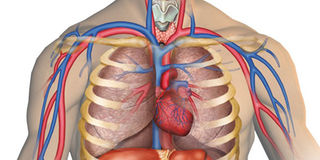Counting the atoms in a human body

FILE
How many atoms are there in a human body? Well, it depends on the size of the body.
The average adult weighs about 70kg and, even though we know that some people can tip the scale at double that figure, we can still use it to get a fairly good estimate – or at least a feel of the order of magnitude.
The other quantity needed is the average mass of an atom. Now here the variation is much wider. The heaviest atom is over 200 times the mass of the lightest one.
The principle behind the measurement of the mass of an atom is straightforward: you simply fire an ion though a magnetic field of known intensity at a known velocity and then measure the angle of deflection. Plug the numbers into a formula and voila! The answer pops out.
It turns out that the masses of atoms are range between 0.000,000,000,000,000,000,000,000,001kg and 0.000,000,000,000,000,000,000,001kg. Those numbers are extremely small, but the latter is 100 times the former. The first one has 27 decimal places and the second one has 25.
Twenty-seven decimal places are a thousandth of a trillionth of a trillionth while the larger number is a tenth of a trillionth of a trillionth. Thus we can immediately expect that number of atoms in a human body should be in the order of thousands of trillion of trillions – a number with 27 zeroes.
Now the human body contains a lot of water – about 55 per cent of the mass. Thus out of the 70kg, about 38kg is water. But a water molecule is made of two atoms of hydrogen and one of oxygen – that’s why it is written as HO.
The mass of one water molecule is about 30 thousandth-trillionth-trillionths of a kilogramme. Therefore, there are 1.27 thousand-trillion-trillion water molecules. We get this by dividing 38kg by the molecular mass. But each molecule has three atoms – two of hydrogen and one of oxygen; therefore, this makes a total of 3.8 thousand- trillion-trillion (38 followed by 26 zeroes).
The remaining 45 percent of mass (or 22kg) mainly comprises of hydro-carbons; that is compounds of hydrogen and carbon. Other elements are calcium (in bones), nitrogen and phosphorous (both in DNA). All together, they make up about another two thousand-trillion-trillion atoms. This brings the total to about six thousand-trillion-trillions. Or, the number six followed by 27 zeroes.
Now that’s a huge number. It is about 100,000 times the number of all the stars in the observable universe. Which brings me to a strange idea: What if our universe is just a humongous creature and the stars and galaxies are atoms and molecules that make up this being?
It’s not farfetched; Ernest Rutherford did a similar extrapolation (albeit in reverse) when he proposed the nuclear model of the atom – it looks like the solar system with a nucleus (sun) the centre and electrons (planets) revolving around it in orbits.




